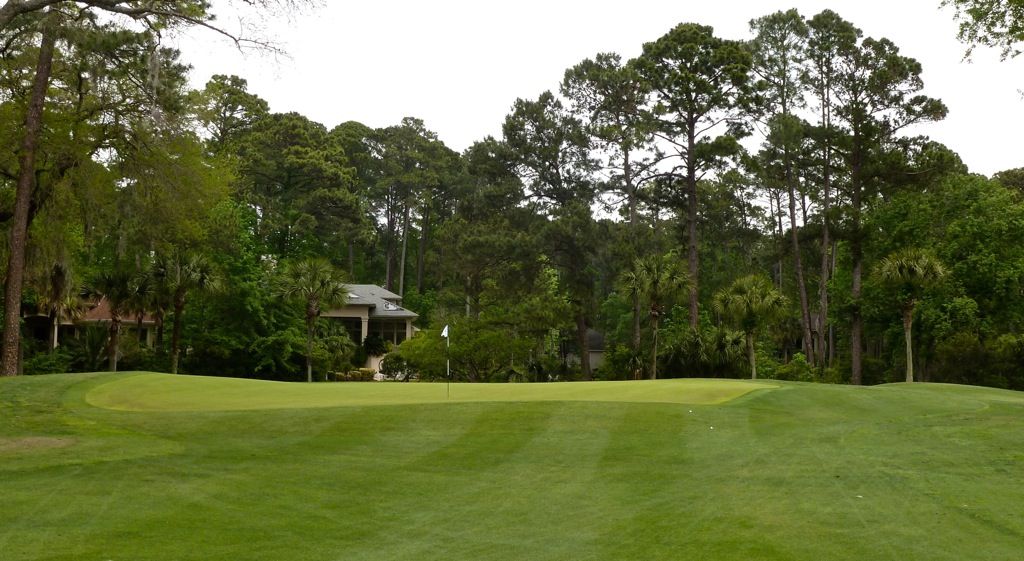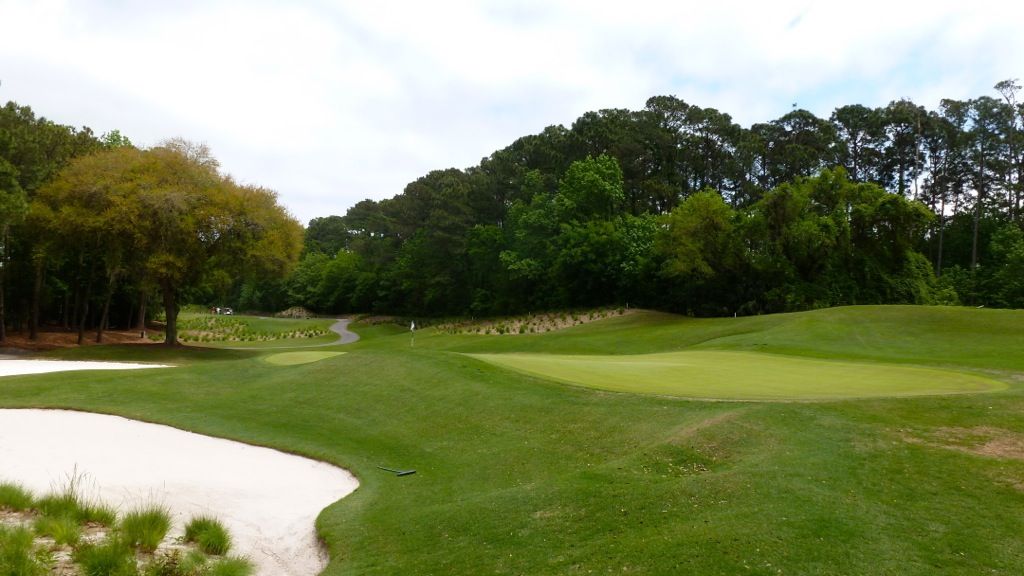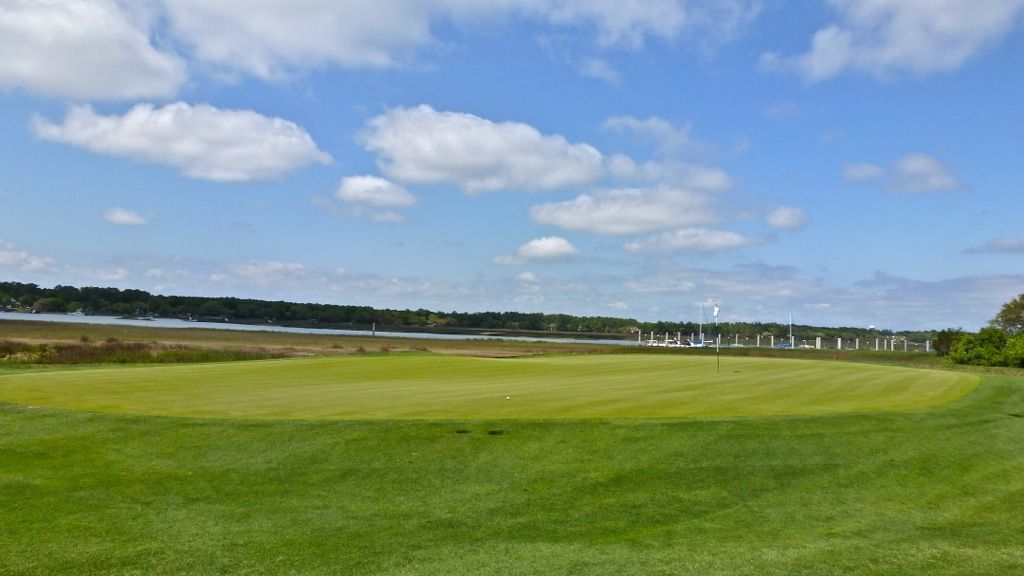Hilton Head Island, South Carolina
Architect: Pete Dye (1981)
7,026 Yards, Par-71
Rating/Slope: 74.8/142
My Quick Review: Another exceptional early Dye.
When I write about Pete Dye's courses, especially those I think are his best, I find that I write the same thing over and over -- Pete Dye has a phenomenal appreciation for both the importance of temptation/doubt in the golfer's mind, and his use of angles. The same holds true at LCC.
I was told that LCC was built shortly after TPC Sawgrass had been negatively received. As such, Pete shied away from designing what golfers would call 'unfair' and instead focused on width, angles and interest around the green. And boy was he successful. Is this Dye's greatest set of greens? They are remarkably varied -- size, shape, tilt, contour -- no two greens are alike and all are interesting. I hope this is made clear throughout the photo tour.
As the golfer nears Hilton Head Island, his GPS lets him know he is entering golf country!

At the 1st, Dye tempts the golfer to play near the bunker/hazard running the right side of the hole, but it is approaches from the left that have the preferred angle. An excellent reverse-dogleg.

The 1st green, as seen from behind, is massive. Two ridges create bowls at the front and right portions of the green.

At the 2nd, a 175 yard par-3, Dye cleverly varies the angle from different sets of tees. The back tees play near 200 yards and well to the left, demanding a longer forced-carry over the hazard.

As seen from behind, the green is much larger than it appears from the tee, but its front-right to back-left tilt makes it a very elusive target. Tee shots that bailout away from the water leave a very difficult recovery.

The third is a mid-length par-5 that twice crosses an angled water-hazard before leaving this seemingly innocuous approach:

But, the green lays at a sharp angle, tilts severely from back-left to front-right, and is guarded by swales both short...

And long!

A handful of holes at LCC are very narrow and constrained by trees. Moreso at the 11th than the 4th, trees create strategy.

The green at the 4th is extremely well-done, tying in exceptionally with the surrounding grade and using subtle mounding at the front and perimeter of the green to maximum effect.

The 5th is a fascinating juxtaposition to the 4th; while the 4th is subtle, the 5th is bold and overt. From the tee the golfer is given ample room to play right, away from the water, on this 300 yard par-4.

But playing away from the water leaves a completely blind approach over an alps-like mound:

While playing to the extreme left side of the fairway leaves an unobscured view of the green:

On the approach there is no bailout as water guards left and bunkers deeper than a golfer lurk to the right. Even the tilt of the green, hard toward the water, adds difficulty.

The mid-length par-5 6th bends to the right around waste bunkers. As the golfer nears the green, the fairway narrows, but fortunately containment contouring adds effective width. Playing from the fairway on the third is a must as this blind, shelf green is intimidating.

As seen from behind, the green tilts away from the line of play:

The front-nine is very much an out-and-back routing, and the 7th is the third of five holes that run in the same direction. Once again the golfer is given ample room off the tee, but it is the angled, swaled green that requires precision.

The 8th is a par-3 of some 180 yards for most, though a back tee can stretch the hole to close to 230. The downhill tee shot is fairly inviting, but it is when the golfer misses that he realizes all of the trouble.

As seen from behind-right, this angle gives a good indication of the size of the ridge in the 8th green:

Something of an awkward, long par-4 where precision is demanded from the tee. First time golfers will have trouble selecting an ideal line as a hidden bunker lurks left a jut of trees sit ready to block-out tee shots down the right...

After a perfectly placed tee shot on this second reverse dogleg of the nine, the golfer is left with an approach over a series of foreshortening bunkers:

The 9th green is smaller than most on the course and easily the most internally contoured on the front-nine.

The 10th hole is the second of a quarter of doglegging par-4s, though the transition from treed to open to treed to open keeps the holes from feeling repetitive. This is yet another reverse dogleg and a hole whose approach looks far easier than it plays:

Looking back from the green, bunkers that were hidden on the approach are now clearly seen:

A look at the wrap-around bunker behind the 10th green:

The 11th is routed through trees though not constrained; the golfer must play near the lone fairway bunker to have a clear view of the green,

Which is small and severely contoured:

After playing through the trees on the tee shot, the 12th hole opens up at the dogleg . The green is large, tilting toward the water, and defined by a green running through its centre:

After a long transition, the pay-off is the stunning view from the tee on the 130 yard par-3 13th:

Another green that is subtle and extremely difficult as the high back-right side sits several feet above the front-left:

Missing long is not an option:

The 14th can play brutally difficult, especially if into the wind on the day I played it. A good example of Pete Dye using the Line of Instinct to tempt the golfer to play too far to the left:

Playing away from the trouble leaves this clear view of a green

That tilts severely from back to front:

The simplicity of the tee shot on the par-5 15th gives way to a series of trees, bunkers and mounds on the lay-up and approach.

A double hazard awaits along the left...

And on the right!


Like at the 2nd, Dye varies the angle from the tee on the par-3 17th with the back set demanding a far longer carry over water.

Internal contouring splits the green into 3 bowls:

A good, mid-length finisher with a tee shot over a diagonal bunker that protects the short line into the green:

The green is massive and tilted severely from back to front:


No comments:
Post a Comment